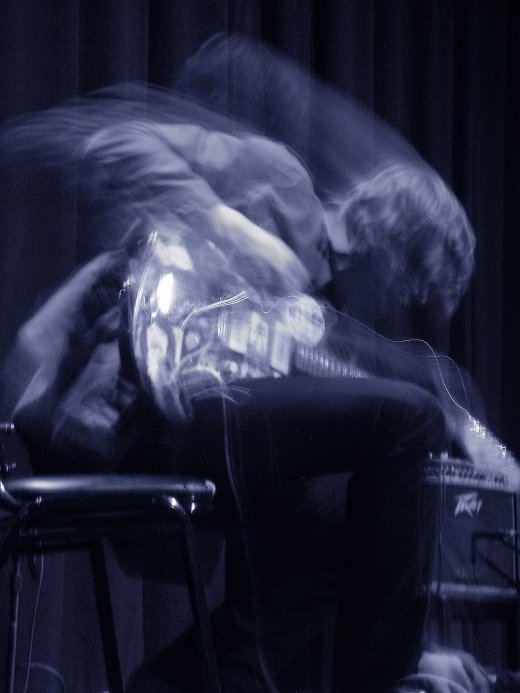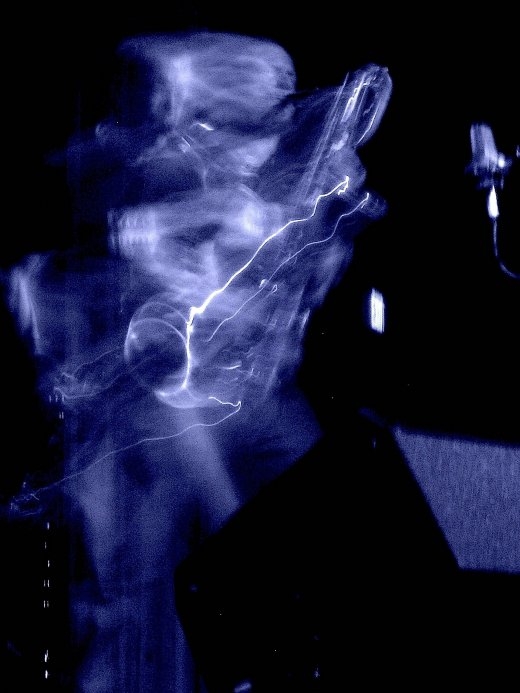
HOWL: Thurston Moore, International House, Last Night [Photos: JONATHAN VALANIA]
 BY DAVE ALLEN I counted about a dozen walkouts from Thurston Moore and Mats Gustafsson’s performance at International House last night. The duo’s aggressive and experimental playing on guitar and saxophone, respectively, tested the limits of what two instruments, with but six strings and one strip of wood between them, could do, but it also tested the audience’s patience and tolerance of noise. During quieter moments, the duo’s playing resembled a static-smeared AM radio receiver rapidly cycling between stations, and during the louder moments they sounded like dueling atom smashers. Those who left the near-capacity crowd certainly missed some punishing aural moments, as well as some astonishing ones, but the pleasures of the experience were as fleeting and ephemeral as the concert itself: A dense force field of noise, destined to evaporate from memory once the ringing left our ears.
BY DAVE ALLEN I counted about a dozen walkouts from Thurston Moore and Mats Gustafsson’s performance at International House last night. The duo’s aggressive and experimental playing on guitar and saxophone, respectively, tested the limits of what two instruments, with but six strings and one strip of wood between them, could do, but it also tested the audience’s patience and tolerance of noise. During quieter moments, the duo’s playing resembled a static-smeared AM radio receiver rapidly cycling between stations, and during the louder moments they sounded like dueling atom smashers. Those who left the near-capacity crowd certainly missed some punishing aural moments, as well as some astonishing ones, but the pleasures of the experience were as fleeting and ephemeral as the concert itself: A dense force field of noise, destined to evaporate from memory once the ringing left our ears.
From the start, the duo held nothing back. Moore took to his guitar with a screwdriver, wrenching out metallic shrieks and piercing scratches. Gustafsson conjured multi-phonics from his baritone sax in a relentless attack that produced multiple notes and all the fractured squawks in between. Some of the lowest notes on the instrument were forced in to high, ringing overtones by Gustafsson’s fire-breathing exhalations.
There was little, if any, rhythmic coordination or communication between the players; sax roars and guitar jolts bleated and darted wherever and whenever they wanted. At one point, Moore kept a kind of beat by rapping the strings with a drumstick. That approach produced a bright, leaping pulse like a video game ray gun, one of a few bits that stood out of the din. He later stuck the drumstick between the neck and the strings and moved it back and forth like a capo or slide, a favorite gesture from the salad days of Sonic Youth, the longest-running of Moore’s many avant-garde projects.
During what could have been the evening’s second movement, both players busied themselves with pedals and other pitch-shifting devices.Gustafsson set down his saxophone entirely and manipulated pitches with a liberal dose of feedback. Intermittently, Moore engaged in what looked like traditional guitar heroics — fleet-fingered runs at the top of the neck, switch-flicking, whammy bar toggling, and faintly VanHalen-esque finger-tapping — but they produced nothing like typical sounds.
Near the end of the session, Gustafsson employed what looked like a flute with a saxophone mouthpiece jammed onto the end. He took a lighter approach on this instrument, clacking keys and exploring breathy attacks. He returned to the baritone near the end, moving from helicopter-like tonguing to broad, forceful honking as at the beginning. The jam ended quietly, and only during the applause did Moore uncoil from his seat to show his long, lanky self: easily six feet, six inches tall, maybe more.Gustafsson had dwarfed him throughout the evening, standing with feet apart and chest stuck out like a saxophone colossus.
A second, shorter jam — Moore called it “the three-minute piece,” though it went on longer than that — began with low, fat thuds from Gustafsson before turning into a bout of guitar vs. amplifier. The storms of distortion during the encore were even louder than before. After more than an hour of prickly, unceasing abstraction, nothing could have been more jarring than when Moore shut off the power to the whole array of pedals and processors. We were plunged into silence to wonder what we’d just heard and then struggle to remember it. Trying to make sense of it, though, would prove ill-advised if not beside the point.

